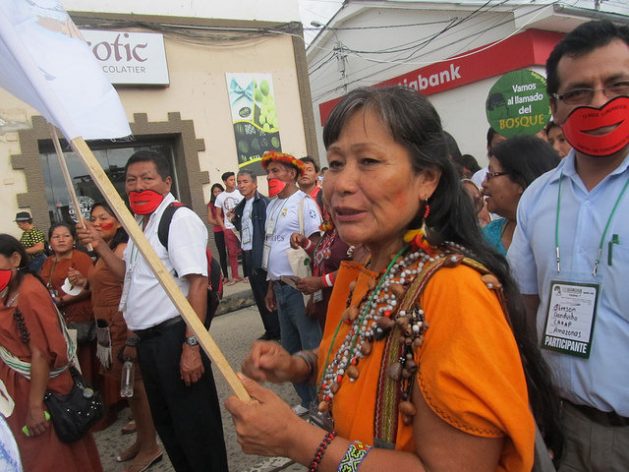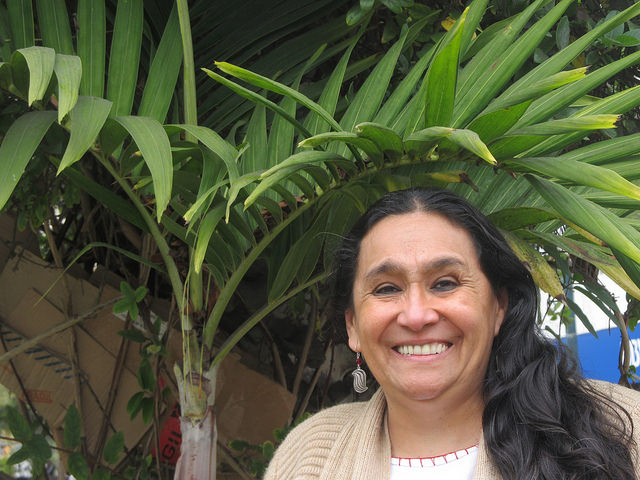“At the age of 18 I was the first female leader in my organisation, my grandfather who was a male chauvinist demanded that I be beaten because I was sitting among men,” said Teresita Antazú, an indigenous leader of the Yanesha people in Peru’s Amazon region.
Now, almost 57 and after a lifetime dedicated to breaking down barriers, she believes that over the past three decades, indigenous women in her country and throughout the Andean region have achieved visibility, formal recognition of their rights and openness of institutions to their demands.
But they are still victims of violence compounded by the fact that they are both indigenous and women. They also face discrimination and growing threats to their territories, as Antazù – the first female “cornesha” (highest authority) of the Federation of Yanesha Native Communities – told IPS from her home town of Constitución, in the jungle in central Peru.
For Rosa Montalvo, an Ecuadorian documentary filmmaker who has worked for 25 years with indigenous women in the Andean region, the current struggle for territory and equality is a common thread providing continuity with the exploits of Bartolina Sisa, an Aymara resistance leader executed on Sept. 5, 1782 for rebelling against the Spanish conquistadors.
It was in homage to Sisa that the Second Conference of Latin American Organisations and Movements, held in Bolivia in 1983, declared Sept. 5 the International Day of Indigenous Women.
“Like Bartolina Sisa, indigenous women today are struggling to keep their cultures alive in their communities, to continue to exist as peoples and to have the opportunities they deserve, preserving the continuity of the new generations, especially now that there are stronger attacks on their territories,” Montalvo told IPS from Quito.
She was referring, for example, to the case of Colombia, where the National Indigenous Organisation, which groups 102 native peoples, reported that between November 2016 and July 2018, 65 activists were killed by illegal armed groups. This was after a peace deal signed by the government and left-wing guerrillas put an end to half a century of armed conflict.

“Indigenous communities have been left more vulnerable in a serious scenario of territorial disputes, with women being severely affected because they remain in their territories to sustain life and are exposed to violence,” explained Montalvo, who is also a member of the non-governmental International Land Coalition.
Indigenous territories are also under threat, with impacts on the lives of native peoples and women, in countries like Ecuador and Bolivia despite their progressive constitutions, said Montalvo.
“Both countries still have an agro-export economic model, which poses a threat to indigenous territories,” said the Ecuadorian documentary-maker.
Territory is life for indigenous peoples and women, it is their source of livelihood, and the basis for their culture and worldview. If their territory is encroached upon, their very existence is jeopardised.
The Andean States have signed the United Nations Declaration on the Rights of Indigenous Peoples and International Labour Organisation Convention 169, which guarantee prior, informed consultation in order to carry out investment projects in the territories of indigenous communities.
However, these commitments are not enforced and extractive activities are impacting on the livelihoods, cultures and worldviews of native peoples, say experts and indigenous leaders.
“That is why we speak of several types of violence, as violence that occurs against our bodies and in our territories,” Tarcila Rivera, a Peruvian member of the United Nations Permanent Forum on Indigenous Issues, told IPS.
Rivera, vice president of the Center for Indigenous Cultures of Peru (CHIRAPAQ), which she founded 34 years ago, said that nearly half of the indigenous women in Latin America live in territories where concessions for mega-projects and extractive activities have been awarded by the governments.
These are areas which, at the same time, are plagued by poverty and neglect.
“We are fighting so that in rural areas the rape of a girl is not settled in exchange for money or goods, and to prevent the dispossession of our lands and the pollution of our rivers and crops,” she said in Lima.
Rivera is a world-renowned indigenous activist who follows the teachings of her mother in her native Ayacucho, the central region of the Peruvian Andes struck especially hard by the 1980-2000 armed conflict.
“My mother died illiterate, but she had great wisdom in dealing with problems and coming up with solutions,” she said.

“If you want a new skirt or something special to eat, she would tell me, you have to have your own money; you have the capacity and spiritual strength and you can get ahead,” she said, recalling her mother’s advice, which taught her to be independent and strong.
In more than 30 years of national and international activism for the rights of indigenous women, she notes as important achievements that indigenous women have organised, are speaking with their own voice and are articulating from the local to the global level.
Rivera also promotes the Continental Network of Indigenous Women of the Americas, and identifies as an international priority the eradication of racism against indigenous women, which she considers one of the structural forms of violence they suffer.
“Racism hurts people’s self-esteem, it is discrimination against your ethnic identity, it makes you feel less of a person because you’re a woman, because you do not speak Spanish, because you’re poor, because you live in the bush,” she said.
As a result, “you don’t have the tools to defend yourself against either the man who beats you in your home or the policeman who abuses you unjustly for claiming your rights, and we have to eradicate that in our countries,” said the indigenous leader.
In the Andean region, according to data from the Economic Commission for Latin America and the Caribbean (ECLAC), Bolivia has the highest percentage of indigenous people (62 percent of the population), followed by Peru (24 percent), Chile (11 percent), Ecuador (seven percent), Colombia (3.0 per cent) and Venezuela (2.7 per cent).
It is also necessary to break down the data by gender and establish different variables to assess violence, health, employment, education and housing, both Atanzú and Rivera pointed out.
“If governments do not know how indigenous women live and the problems we face every day, they will not be able to make public policies that respond to our needs,” Antazú said.
When asked about their outlook over the next 10 years, they see a more equitable presence for indigenous women in decision-making spaces at the local, regional and national levels, and they believe indigenous girls and young women will increasingly receive a quality education that empowers them.
“And without people shooting looks at us that shout: ‘what are you doing here?’” Rivera remarked.
Our most important fundraising appeal of the year
December is the most critical time of year for Truthout, because our nonprofit news is funded almost entirely by individual donations from readers like you. So before you navigate away, we ask that you take just a second to support Truthout with a tax-deductible donation.
This year is a little different. We are up against a far-reaching, wide-scale attack on press freedom coming from the Trump administration. 2025 was a year of frightening censorship, news industry corporate consolidation, and worsening financial conditions for progressive nonprofits across the board.
We can only resist Trump’s agenda by cultivating a strong base of support. The right-wing mediasphere is funded comfortably by billionaire owners and venture capitalist philanthropists. At Truthout, we have you.
We’ve set an ambitious target for our year-end campaign — a goal of $250,000 to keep up our fight against authoritarianism in 2026. Please take a meaningful action in this fight: make a one-time or monthly donation to Truthout before December 31. If you have the means, please dig deep.
